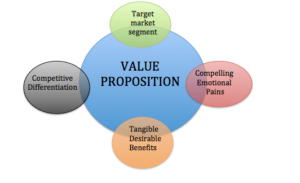
Create a Sense of Urgency in the Cloud
November 23, 2016
Leverage the Five Key Global Economic Trends in 2017 to Drive Cloud Adoption
May 18, 2017Reading Time: 5 minutes
So, how do you define value?

Free Value Proposition Generator
For more reading on this topic see Michael Treacy’s book “The Discipline of Market Leaders,” https://www.amazon.com/Discipline-Market-Leaders-Customers-Dominate/dp/0201407191

How to Define a Compelling Value Proposition
People don’t buy products and services. They buy a solution to their problem.
In my experience auditing dozens of websites I’ve found that very few have a clear value proposition identified for prospective customers. Most of the time I have to weed through lists of product features to find anything that even remotely feels like value. So, I’ll attempt to help you quickly identify your value proposition here.What is a value proposition?
A value proposition is simply a description of the value your company promises to deliver.So, how do you define value?
- This value needs to be important from the customer’s perspective, not from your view. For example, my business may offer 24-hour customer support, which I see as delivering great value, but if the client never needs to call after 5 pm then there is no benefit from their perspective.
- The value needs to be relevant, significant, and critical to the prospect. It needs to promise something that is desirable enough for them to invest money in to obtain. It needs to be instrumental in getting them to a new, highly desirable state.
- The benefit needs to be specific, observable, measurable, and tangible. You need to prove that you delivered on the promise they paid for.
- Your value needs to also be unique. If all your competitors promise to provide the same value, then your value proposition is weak. For example, having talented, technically skilled employees is only valuable if all your competitors have poorly skilled workers in comparison.

What types of value proposition are there?
Most marketing experts will agree that there are really only four different types of value propositions for you to choose from. I will explain them here:-
Lowest Price
-
Product leadership
-
“We make life easier for you”
-
Customer dependency and intimacy
Free Value Proposition Generator
For more reading on this topic see Michael Treacy’s book “The Discipline of Market Leaders,” https://www.amazon.com/Discipline-Market-Leaders-Customers-Dominate/dp/0201407191
Sharka Chobot
Sharka Chobot is the creator of the CRM product category (1995) and Chief Transformation Officer of Neural Impact. Sharka applies research from behavioral economics, neuroscience and persuasion psychology to help technology providers develop an effective customer acquisition and go to market strategy. She has over 30 years of technology-specific expertise and teaches behavioral marketing at universities in Canada. Sharka has worked with hundreds of tech companies on six continents to develop their cloud product, packaging, pricing, and vertical market strategy and to accelerate their transition to a SaaS business model.


